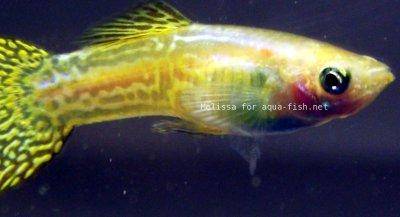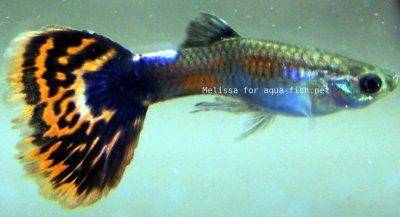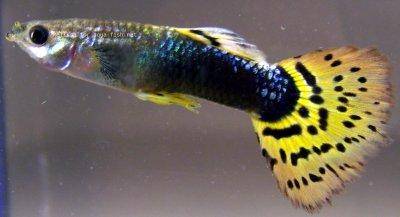The Guppy Fish – Ultimate Guide on Breeding, Diet, Sexing, and Care
Quick Navigation
- Feeding & Nutrition
- Tank Setup & Environment
- Breeding & Reproduction
- Biology & Lifespan
Brief Description
This guide will help you raise healthy and colorful Guppies. It covers common problems, practical tips, care instructions, and pictures. Guppies (Poecilia reticulata) are one of the most popular freshwater fish in the world. They are peaceful, small, full of color, and easy to breed. That makes them perfect for both beginners and experienced fishkeepers.
Guppies are a type of livebearing fish, which means they give birth to baby fish (fry) that can swim right away. Besides being fun to watch, Guppies also help control mosquitoes in some places by eating their larvae. This makes them useful as well as beautiful.
Whether you’re just starting out or already keeping Guppies, this article has everything you need. You'll learn about feeding, tank setup, breeding, and more. At the bottom of the page, there’s also a Q&A section where you can read answers or ask your own questions.
Origin and Natural Habitat
Guppies (Poecilia reticulata) come from many different freshwater habitats across South America, Central America, and several Caribbean islands. In the wild, they live in slow-moving streams, ponds, and even slightly salty (brackish) waters. This explains why they are so easy to keep in many kinds of aquariums.
The species was first discovered in Trinidad in 1866 by Robert John Lechmere Guppy, who gave the fish its common name. At first, it was named Girardinus guppii, but that changed later. The name "Guppy" honors his role in discovering and documenting the fish.
Because Guppies are adaptable and eat mosquito larvae, they were introduced to many tropical and subtropical regions to help control mosquito populations. In some parts of the world, they still serve this purpose today.
In nature, Guppies thrive in both soft and hard water, with a pH between 7.0 and 8.0. Since they often live in slightly brackish environments, some aquarists add a small amount of aquarium salt to mimic these conditions—especially in tanks without live plants or when raising fry. However, salt is not necessary if the water is clean and stable.
Guppies are probably the most popular aquarium fish in the world. They’re small, peaceful, colorful, and full of energy. Some types are very affordable, while others—especially show-quality varieties—can be expensive. Guppies are hardy and easy to breed, which makes them a top choice for beginners and kids. Just keep in mind that even easy fish need proper care and a healthy environment. Without it, they can get sick like any other fish.
Sexual Dimorphism in Guppies
Male and female Guppies look very different. Females are larger, rounder, and usually gray or silver. Males are smaller but much more colorful, with bright patterns and long flowing fins. In fact, some beginners think they’re two separate species!
There are many Guppy varieties, and breeders often create new ones through selective breeding. A well-known example is the Endler's Guppy. When fully grown, Guppies typically measure between 4.0 and 6.0 cm (1.6 to 2.3 inches) in length.
Tail Types and Color Varieties
One of the most interesting things about Guppies is how different they can look. Over many years of selective breeding, aquarists have developed Guppies with a huge variety of tail shapes, colors, and patterns. Below are some of the most common types you’ll see:
Common Tail Shapes
- Delta Tail: A wide, triangle-shaped tail with sharp edges. Very popular and easy to recognize.
- Fan Tail: Similar to the Delta, but with smooth, rounded edges—like a fan.
- Double Sword Tail: Two thin extensions—one on top and one below the tail fin.
- Top Sword / Bottom Sword Tail: A single extension, either on the top or bottom of the tail.
- Pin Tail: A narrow tail that comes to a sharp point, like a pin.
- Round Tail: A small, circular tail—simple but elegant.
- Veil Tail: A long, flowing tail that drapes behind the fish like a veil.
- Lyre Tail: The edges curve outward, forming a lyre-like shape with a shorter center part.
- Crown Tail: Spiky-looking tail where the fin rays extend past the webbing.
Tail Patterns
- Solid Color: The entire tail is one single color.
- Spotted: Small or large spots of different colors.
- Mosaic: A broken or patchy pattern—often colorful and irregular.
- Snake Skin: A wavy or chain-like pattern that looks like snake scales.
- Tuxedo / Half Black: The front part of the body is one color, while the back half is dark or black.
Body and Tail Colors
Guppies can show just about every color you can imagine, including:
- Red
- Yellow
- Blue
- Green
- Purple
- White
- Black
- Metallic shades like gold, silver, or shimmering rainbow tones
Most Guppy types are named after their tail shape and color. Examples include “Red Delta,” “Blue Moscow,” or “Green Cobra.” These traits are passed down from parents to fry, so breeders can create specific lines by choosing the right pairs.
If you're planning to breed fancy Guppies, learning about tail shapes and color genetics is a great starting point. It helps you choose strong, healthy fish and produce beautiful, consistent offspring.
Feeding & Diet
Guppies are not picky eaters. They will happily accept a wide variety of foods, including flakes, Spirulina, lettuce, bloodworms, spinach, mosquito larvae, and freeze-dried products. However, just because they’ll eat almost anything doesn’t mean all food is good for them.
Always choose high-quality food. Poor-quality products can shorten your Guppies’ lifespan and weaken their immune system. Look at the ingredients on the packaging. If the label only reveals part of the content—like “40% protein” but doesn’t list the full ingredients—it’s better to avoid it. The more transparent the label, the better the food.
Since Guppies have very small stomachs, they should only be fed small amounts at a time. A good rule is to give them food they can finish within 2–3 minutes.
Important tip: Before feeding flakes, soak them briefly in tank water. This softens the food and helps prevent digestive problems like bloating.
Adults do best on a low-calorie, balanced diet with occasional treats like live or frozen food. Fry and juveniles, on the other hand, need more energy. Their food should be higher in protein and fat to support fast growth. Be sure to remove any uneaten food quickly—this keeps the water clean and helps prevent disease.
Feed Guppies at least three times per day, in small portions. Watch them while they eat—healthy Guppies will be active and show interest in food. If a fish ignores food or looks sluggish, it may be stressed or sick.
Guppies will even eat what’s already in the tank, including their own fry or the eggs of other species. For example, they’re known to eat Panda Cory eggs if they’re not well hidden.
One day of fasting per week is a great way to let their digestive systems rest. This simple routine can improve their long-term health and even extend their lifespan.
Breeding Guppies and Caring for the Fry
Guppies are incredibly easy to breed. As livebearers, they give birth to free-swimming fry instead of laying eggs. When males and females live together, breeding often happens on its own—no special effort is needed.
For healthy offspring, both parents should be adults in good condition. Avoid using fish that are too old. Female Guppies live for 2–3 years on average, and fertility drops after the age of 2. Females reach sexual maturity at around 3 months, while males are usually ready a bit earlier. Males will actively court females by flaring their fins and performing a curved-body "dance."
After mating, the female is pregnant for about 28 to 30 days. A dark, triangular gravid spot near her tail becomes larger as birth approaches. Her belly will also swell and take on a more rectangular shape.
Key tip: Move the pregnant female to a breeding tank or breeder box shortly before she gives birth. This reduces stress and protects the fry. Guppies don’t care for their young—both parents may eat the babies unless they have hiding spots like floating plants or fine-leaved vegetation.
Each brood usually contains 20 to 40 fry, but some large females can have 60 or more. One female can produce multiple broods—often 7 or more during her life—because she can store sperm and use it for future pregnancies without another mating.
Baby Guppies are born fully formed and ready to swim and eat. Start feeding them with finely crushed flakes, infusoria, or baby brine shrimp. Clean water and frequent small feedings are essential during their first weeks of life.
To keep your fish healthy over generations, avoid inbreeding. Do not breed siblings or closely related fish repeatedly. Inbreeding can cause deformities, weak immunity, and poor fertility. Always introduce unrelated Guppies from other sources to strengthen the genetics in your tank.
Advanced tip: If you're aiming to create or preserve specific colors or fin shapes, selective line breeding may be an option. This involves keeping fish from the same strain and choosing pairs carefully over several generations. It’s best left to experienced aquarists, as it requires close observation to avoid health issues.
Tank Conditions and Water Parameters
Guppies do best in warm water, ideally between 23–24°C (73–75°F). They can handle a wider range from 19–29°C (66–84°F), as long as the pH stays stable between 7.0 and 8.5.
As for water hardness, aim for 12–18 °N (214–321 ppm or 4.29–6.43 mEq). Guppies are adaptable and will tolerate slightly softer water, but staying within this range ensures long-term health.
Tip for planted tanks: A tank with live plants is strongly recommended. Species like Vallisneria spiralis, Echinodorus amazonicus, and Cabomba furcata are excellent choices. They help oxygenate the water, enhance the look of your aquarium, and offer safe hiding places for baby Guppies.
Water too soft or acidic? Try adding a small amount of coral sand or crushed coral to the substrate or filter. These materials dissolve slowly and act as a natural buffer, helping to stabilize pH and hardness over time.
Important when adding new Guppies: Always acclimate them slowly. Start by floating the transport bag in your tank for 15–20 minutes to match the temperature. Then gradually add small amounts of tank water into the bag over another 20–30 minutes. This helps the fish adjust and reduces stress.
After release: Watch your Guppies closely for the first hour. Healthy fish should swim around actively, explore, and show curiosity. If any fish hides, lies at the bottom, or looks disoriented, they may be stressed. To help them settle in, avoid feeding right away and dim the lights.
Tank Mates: What Works and What Doesn’t
Guppies are peaceful and social fish. They should never be kept alone. Instead, they do best in community tanks with calm, friendly species.
However, avoid fish with long fins or aggressive behavior. Guppies may nip at long fins, and more aggressive fish can stress or injure them.
Keep at least three females for every male (1:3 ratio). This helps reduce stress, especially from constant male chasing during breeding behavior.
Tank mates to avoid:
- Gouramis
- Paradise fish
- Siamese fighting fish
- Blue Acara, Jack Dempsey cichlids, Texas cichlids, and most large Central or South American cichlids
Compatible tank mates include:
Tank Size Requirements
Guppies love to swim and interact, so they should be kept in groups of at least 10–15 fish. This means you’ll need a tank that offers enough space and good water quality.
A tank smaller than 20 liters (5.28 US gallons) is too small. And remember, the real water volume is even lower once you add substrate, decorations, and equipment.
Recommended minimum: For 10–12 Guppies, use a tank of at least 40 liters (10.56 US gallons, 8.8 Imperial gallons).
Although a single Guppy can technically survive in a 5-liter tank (1.32 US gallons), it's far from ideal. Small tanks make it hard to maintain stable conditions and don’t support healthy social behavior.
Tip: Bigger tanks are easier to manage and offer better stability, which benefits both beginners and experienced aquarists.
Why Fish Bowls Are Unsuitable
Never keep Guppies in a small fish bowl! Bowls may look cute, but they often cause serious problems like poor oxygen levels, unstable water chemistry, and disorientation. These issues can quickly lead to illness or early death.
If you absolutely must use a bowl, choose the largest one available—ideally 60 liters (15.85 US gallons) or more. Still, a proper rectangular tank is far better in every way.
Tip: To make your Guppies feel secure and behave naturally, decorate their tank with driftwood, live plants, or small caves. Also, always use a reliable filter and heater for stable conditions.
Diseases of Guppies
Like all aquarium fish, Guppies can suffer from diseases—especially if their water quality is poor or their environment is stressful. Clean, stable water is the most important defense against illness.
Stress weakens their immune system. Overcrowding, sudden water changes, poor diet, or aggressive tank mates can make them vulnerable.
To prevent diseases:
- Keep water free from ammonia, chlorine, and chloramine.
- Maintain a stable pH of at least 7.
- Ensure the water has appropriate hardness and temperature.
- Perform regular partial water changes (about 25% per week).
For more details on symptoms, causes, and treatments, see our article on aquarium fish diseases.
Tip: Observe your Guppies daily. Loss of appetite, clamped fins, or erratic swimming are early warning signs. Catching problems early makes treatment easier and more effective.
Selling or Donating Guppies
If your tank is becoming overcrowded, you might consider selling or donating some Guppies. However, this can be tricky—many pet stores won’t accept fish bred at home due to health and space concerns.
Better alternatives include:
- Bringing them to local fish shows or aquarium markets, where hobbyists are often looking for new stock.
- Advertising through online forums, social media groups, or local newspaper classifieds.
- Offering them to friends, schools, or community aquariums.
Tip: When giving Guppies to someone new, share a few care basics with them to ensure the fish go to a responsible home.
Practical Tips and Frequently Asked Questions About Guppies
Many aquarists—especially beginners—have common concerns when caring for Guppies. To help you avoid common pitfalls and improve your success, we’ve compiled practical tips and answers to frequently asked questions.
- How to Control Guppy Population ❓ Guppies breed rapidly, so population control is important. Try these methods:
- Use a tank divider to separate males and females.
- House males and females in separate tanks.
- Sell or give away surplus fish to local stores, shows, or forums.
- Use Guppies as feeder fish for larger predators like Oscar cichlids or Paradise fish.
- How Much Water Does a Guppy Need ❓ Although some people try to keep Guppies in very small tanks, the rule of thumb is: at least 5 liters (1.32 US gallons) per fish. Avoid “one fish per liter” setups—they cause stress and reduce lifespan.
- Can Guppies Jump Out of the Tank ❓ They’re not strong jumpers, but yes, Guppies can jump. Some may survive up to 10 minutes out of water, but the risk of internal damage is high. Always keep a lid on the tank to prevent accidents.
- How Big Are Guppy Fry at Birth ❓ Newborn Guppies are about 1–2 mm long and 1 mm wide. They swim and eat right away.
- When Do Guppy Fry Get Their Color ❓ Color starts to appear around 2 weeks of age. Most Guppies reach full coloration by 2–3 months.
- What Kind of Fish Are Guppies ❓ Guppies are small, peaceful livebearers from tropical freshwater environments. They belong to the Poeciliidae family and are famous for their easy breeding.
- What Do Baby Guppies Look Like ❓ They resemble tiny adults but are colorless at first. Their patterns and hues develop gradually as they grow.
- What Fish Can Live With Guppies ❓ Guppies do well with peaceful tank mates like mollies, platies, swordtails, neon tetras, and small algae eaters. Avoid aggressive or fin-nipping species such as bettas or tiger barbs.
- When Do Guppies Give Birth ❓ They can give birth at any time of day or night. Provide floating or dense plants so fry can hide from adult fish.
- Best Filter for a 15-Gallon Guppy Tank ❓ Any well-cycled filter will work. For smaller tanks, undergravel filters are affordable and provide plenty of surface area for beneficial bacteria.
Pictures of Guppies
We would like to thank William Yen for kindly providing several of the photos featured in this article. All images below show male Guppies, except for the first one, where you can also see a female in the background. This makes it easy to compare their physical differences.
How to tell them apart? Male Guppies are smaller, more colorful, and have long, flowing fins. Females are larger, with rounder bellies and more subdued coloration. These traits make sexing Guppies quite straightforward once you're familiar with their appearance.
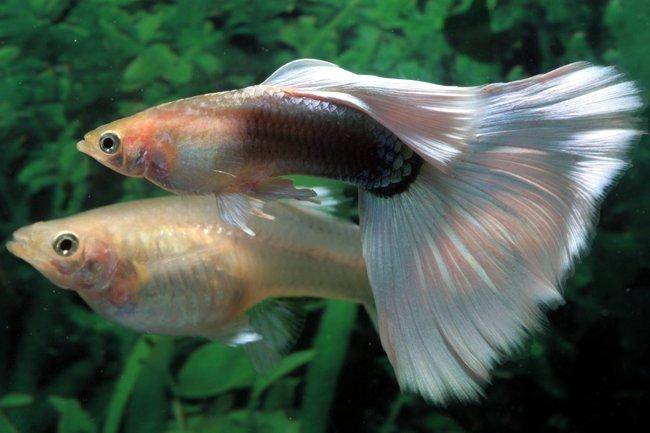
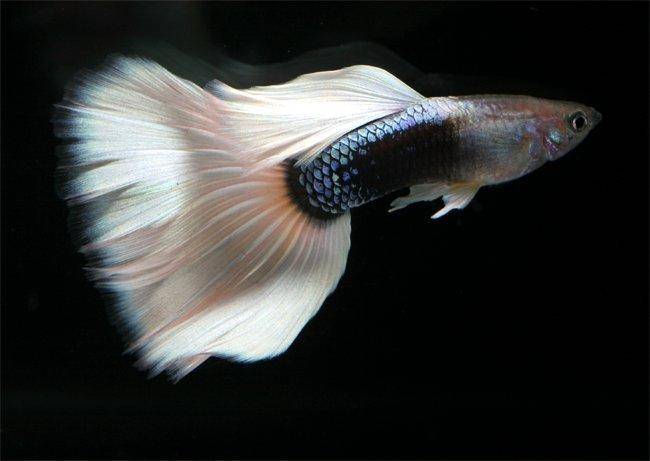
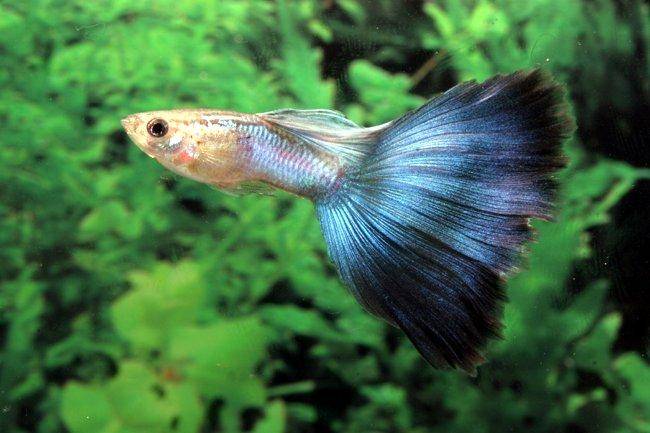
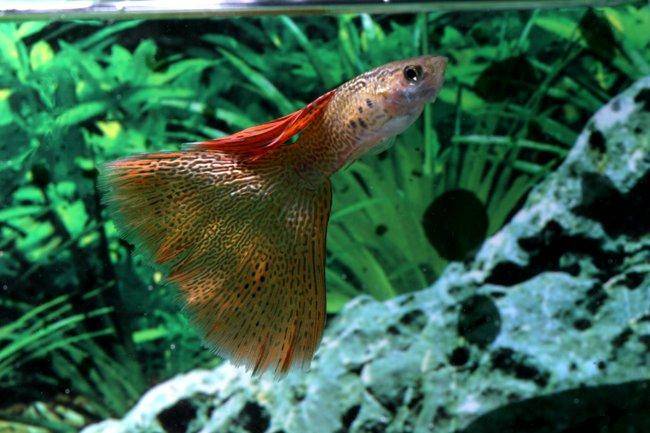
More Guppy Pictures
Small Gallery – Guppy Males
This article is also available in German: Der Guppy
Related Pages About Guppies
Final Thoughts & Tips for Guppy Keepers
Whether you're just starting your journey with Guppies or you've kept them for years, these vibrant little fish offer endless joy, color, and learning opportunities. Their adaptability, peaceful nature, and fascinating breeding behavior make them one of the most rewarding species for home aquariums.
To ensure your Guppies thrive:
- Maintain stable water conditions with regular testing and care.
- Offer a varied, high-quality diet to support health and coloration.
- Plan ahead for breeding and population control if males and females are housed together.
- Use plants and proper tank mates to reduce stress and improve fry survival.
We hope this guide has helped you better understand how to care for Guppies and enjoy everything they bring to your aquarium. If you still have questions or want to share your experience, feel free to scroll down and leave a comment—we’d love to hear from you!
And don’t forget—there’s always more to explore. Check out our related articles, fish profiles, and care guides to continue growing your knowledge.





